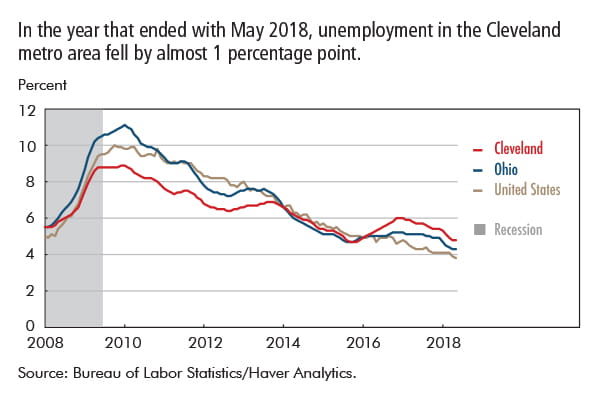Cleveland economy shows signs of real improvement, according to Federal Reserve researchers
A drop in the unemployment rate combined with job growth is helping the local labor market

Economic conditions in the Cleveland metro area continue to improve. In the 12 months leading up to May 2018, the unemployment rate fell by nearly 1 percentage point to 4.8 percent. The rate is still above the 3.8 percent national level, and some of that decline is due to workers leaving the region, but job growth is also a factor.
“The year-over-year drop in the unemployment rate indicates an improvement in labor market conditions because the number of unemployed persons fell by more than the number of people who exited the labor force,” according to Federal Reserve Bank of Cleveland researchers Joel Elvery and Julianne Dunn. While the metro area continues to see year-over-year declines in population, “in more recent years, the outflow has stabilized,” they added.
Employment in the Cleveland area grew by 0.3 percent from December 2016 to December 2017. The fastest growth was seen in the construction sector, increasing 4.4 percent over the period and adding nearly 1,500 jobs. Professional and business services contributed the largest share of employment gains, adding 4,180 jobs, and after declining for nearly two years, employment in manufacturing grew during the second half of 2017 and ended the period with an increase of 0.9 percent.
Education and health services shed nearly 4,000 jobs in the 12 months leading up to December 2017, but remains the region’s largest sector employing nearly 200,000 people. “Though the education sector saw a slight decline, most of the loss in employment in this sector was in healthcare services,” said Elvery and Dunn.
After a strong 2017, Cleveland metro area building permit issuance declined on a year-over-year basis each month between January and April 2018. “Though many new multifamily housing projects in downtown Cleveland and nearby neighborhoods have added to the number of permits issued, the housing market in the metro area is still dominated by single-family homes, and new construction projects for these have declined,” they added.
For more of Elvery and Dunn’s insights on economic conditions in the Cleveland area, see our latest Cleveland Metro Mix.
And browse through our Region, for data, maps, research, and other information related to the diverse economies and communities in the region served by the Cleveland Fed: Ohio, eastern Kentucky, western Pennsylvania, and the northern panhandle of West Virginia.
Federal Reserve Bank of Cleveland
The Federal Reserve Bank of Cleveland is one of 12 regional Reserve Banks that along with the Board of Governors in Washington DC comprise the Federal Reserve System. Part of the US central bank, the Cleveland Fed participates in the formulation of our nation’s monetary policy, supervises banking organizations, provides payment and other services to financial institutions and to the US Treasury, and performs many activities that support Federal Reserve operations System-wide. In addition, the Bank supports the well-being of communities across the Fourth Federal Reserve District through a wide array of research, outreach, and educational activities.
The Cleveland Fed, with branches in Cincinnati and Pittsburgh, serves an area that comprises Ohio, western Pennsylvania, eastern Kentucky, and the northern panhandle of West Virginia.
Media contact
Doug Campbell, doug.campbell@clev.frb.org, 513.218.1892
- Share
